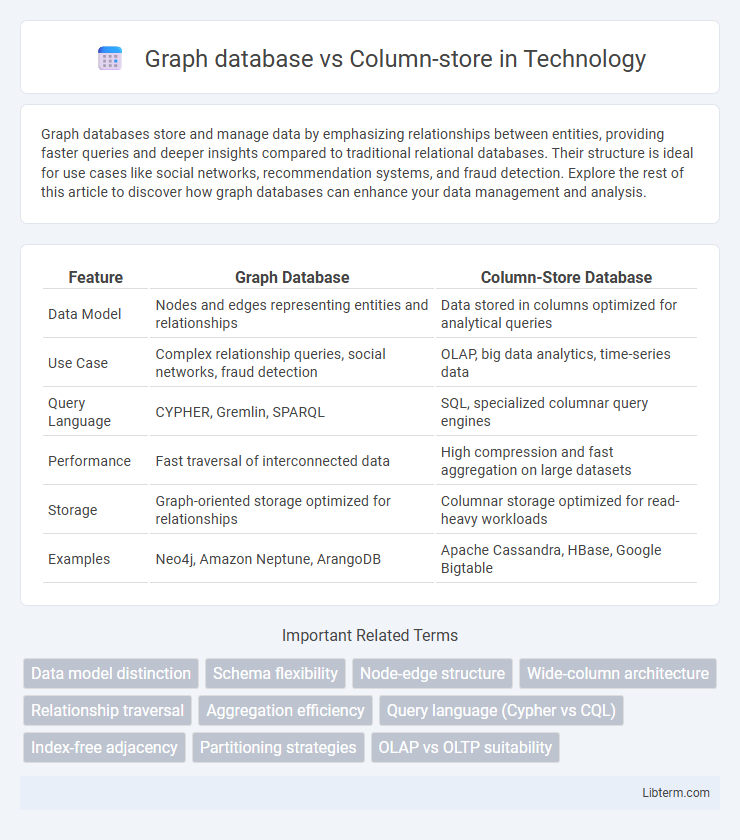Graph databases store and manage data by emphasizing relationships between entities, providing faster queries and deeper insights compared to traditional relational databases. Their structure is ideal for use cases like social networks, recommendation systems, and fraud detection. Explore the rest of this article to discover how graph databases can enhance your data management and analysis.
Table of Comparison
| Feature | Graph Database | Column-Store Database |
|---|---|---|
| Data Model | Nodes and edges representing entities and relationships | Data stored in columns optimized for analytical queries |
| Use Case | Complex relationship queries, social networks, fraud detection | OLAP, big data analytics, time-series data |
| Query Language | CYPHER, Gremlin, SPARQL | SQL, specialized columnar query engines |
| Performance | Fast traversal of interconnected data | High compression and fast aggregation on large datasets |
| Storage | Graph-oriented storage optimized for relationships | Columnar storage optimized for read-heavy workloads |
| Examples | Neo4j, Amazon Neptune, ArangoDB | Apache Cassandra, HBase, Google Bigtable |
Introduction to Graph Databases and Column-Stores
Graph databases organize data as nodes and edges, enabling efficient representation and querying of complex relationships in social networks, recommendation engines, and fraud detection systems. Column-store databases, such as Apache Cassandra and HBase, store data by columns rather than rows, optimizing analytic query performance over large-scale, distributed datasets. Both architectures serve distinct use cases: graph databases excel in traversing interconnected data, while column-stores provide high-speed aggregation and retrieval in big data environments.
Core Architecture: Graph vs Column-Store
Graph databases utilize nodes and edges to represent and store complex relationships, enabling efficient traversal and pattern matching through a highly connected data model. Column-store databases organize data into column families that allow for fast read and write access to specific columns, optimizing aggregation and analytical query performance on large-scale datasets. The core architecture difference lies in graph databases' emphasis on relationship-centric queries versus column-stores' focus on columnar data retrieval and compression for analytical workloads.
Data Modeling Differences
Graph databases model data as nodes, edges, and properties, enabling efficient representation and querying of complex relationships and networks. Column-store databases organize data in columns rather than rows, optimizing for read-heavy analytical workloads and simplifying aggregation operations. The key data modeling difference lies in graph databases' emphasis on interconnected entities, while column-stores focus on schema flexibility and high-performance columnar retrieval.
Performance Benchmark: Queries and Retrieval
Graph databases excel in complex relationship queries and path traversal due to their index-free adjacency, delivering faster performance in connected data retrieval tasks compared to column-store databases. Column-store databases demonstrate superior efficiency in analytical queries involving large-scale aggregation and scanning across columns, leveraging their optimized compression and vectorized processing. Benchmark tests reveal graph databases outperform in recursive and pattern matching queries, while column-stores show lower latency in bulk data retrieval and aggregation workloads.
Scalability and Flexibility Comparison
Graph databases offer superior flexibility by efficiently handling highly connected data and evolving schemas, making them ideal for complex relationship queries and dynamic data models. Column-store databases excel in horizontal scalability and high-performance analytics on large datasets due to their columnar storage format, enabling fast read/write operations and optimized compression. While graph databases scale well for traversals across dense networks, column-stores outperform in bulk data processing and aggregations at massive scale, highlighting a trade-off between relationship flexibility and analytical scalability.
Use Cases: When to Choose Graph or Column-Store
Graph databases excel in managing highly interconnected data such as social networks, fraud detection, and recommendation engines, where relationships and pattern discovery are critical. Column-store databases are ideal for analytical workloads involving large-scale aggregations and fast retrieval of specific columns, commonly used in business intelligence, time-series analysis, and data warehousing. Choosing between them depends on data structure complexity and query patterns, with graph databases favored for relationship-heavy queries and column-store databases preferred for high-performance aggregation and read-heavy operations.
Query Language and API Support
Graph databases primarily use query languages like Cypher, Gremlin, and SPARQL, which are optimized for traversing relationships and pattern matching within connected data structures. Column-store databases, such as Apache Cassandra and HBase, support SQL-like query languages or proprietary APIs designed for efficient retrieval and aggregation of data distributed across columns. Both database types offer extensive API support, with graph databases emphasizing traversal and relationship queries, while column-stores focus on scalable, high-performance access to wide-column data models.
Integration with Big Data Technologies
Graph databases excel in managing complex relationships and integrating seamlessly with big data frameworks like Apache Spark and Hadoop, enabling efficient traversal and analytics on interconnected data. Column-store databases, optimized for high-performance read and write operations on large-scale datasets, integrate well with big data tools such as Apache Cassandra and HBase, supporting distributed storage and fast aggregation queries. Choosing between graph databases and column-store depends on the nature of data relationships and query patterns within big data ecosystems.
Security and Data Consistency Considerations
Graph databases enforce robust security through fine-grained access controls at the node and relationship level, ensuring strict data confidentiality and integrity across complex interconnected data. Column-store databases prioritize atomicity and consistency by implementing strong ACID compliance, which guarantees reliable transactions and prevents data anomalies in large-scale analytical workloads. Both systems require tailored security configurations to address specific use cases, with graph databases excelling in relationship-level access management and column-stores in maintaining consistency during high-volume data processing.
Future Trends in Graph and Column-Store Databases
Graph databases are evolving to support more advanced AI and machine learning applications by enhancing their ability to process complex relationships and real-time data analytics. Column-store databases are increasingly optimized for cloud-native architectures, delivering faster analytics and improved scalability for big data workloads. Both graph and column-store databases are integrating more automation and adaptive indexing techniques to boost performance and reduce manual tuning efforts.
Graph database Infographic

 libterm.com
libterm.com